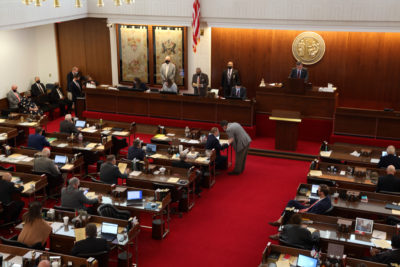
When people think about education, they usually think about schools, classrooms, teachers, and students. But in North Carolina, there is a whole host of other people who hold sway over what happens in school districts.
At the state level, the General Assembly, the State Board of Education, the State Superintendent of Public Instruction, and the governor are the education power brokers. Below them are the local boards of education. The state constitution and general statute have a lot to say about all of these roles and what powers they have. Let’s take a look at each.
Governor
The governor is elected to a four-year term by the voters of North Carolina and his or her duties are laid out in Article 3 Section 5 of the state constitution.
Part 3 of that section talks about his role via the budget, which is one of the biggest ways in which he influences education.
“The Governor shall prepare and recommend to the General Assembly a comprehensive budget of the anticipated revenue and proposed expenditures of the State for the ensuing fiscal period. The budget as enacted by the General Assembly shall be administered by the Governor,” the constitution states.
Here is the section on the governor’s duties in its entirety.
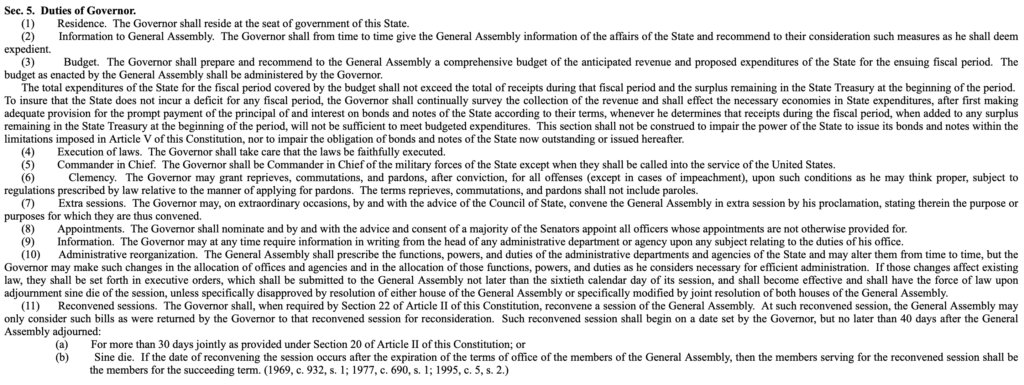
Governors in North Carolina couldn’t veto bills until 1996 when the state voted for a constitutional amendment granting him or her that ability. The veto power is now enshrined in the constitution, but there are exceptions. Here is an excerpt of the constitution outlining bill actions, including the rules for vetoes and bills exempt from vetoes. It’s found in Article 2, section 22.



Article XI Section 4 of the constitution lays out the governor’s power to appoint members to the State Board of Education.

The governor also has the power to convene. For instance, using executive orders, he convened both the DRIVE Task Force and the Commission on Access to a Sound Basic Education. He also serves as the chair of the Education Cabinet, which “is statutorily tasked with working to resolve issues between existing providers of education and developing and maintaining a strategic design for a continuum of education programs, from early childhood into the workforce.”
General Assembly
General Assembly members are directly elected by voters for two years terms in the House or Senate, and the state constitution lays out their role in Article 2, Section 20:
“Each house shall be judge of the qualifications and elections of its own members, shall sit upon its own adjournment from day to day, and shall prepare bills to be enacted into laws. The two houses may jointly adjourn to any future day or other place. Either house may, of its own motion, adjourn for a period not in excess of three days.”
All of Article 2 covers the legislative branch, including vesting the power of the legislative branch in the General Assembly, laying out the number of senators and representatives, saying how they are to be apportioned, and more.
Here is what the state constitution says up to the section about action on bills, which was covered in the governor’s section above.
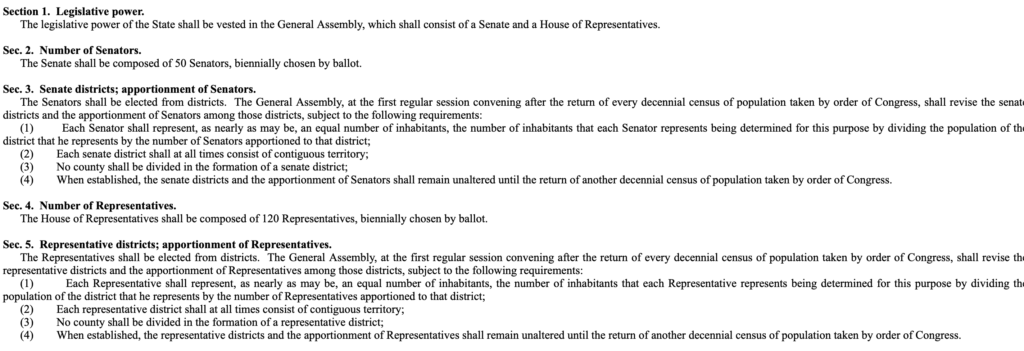
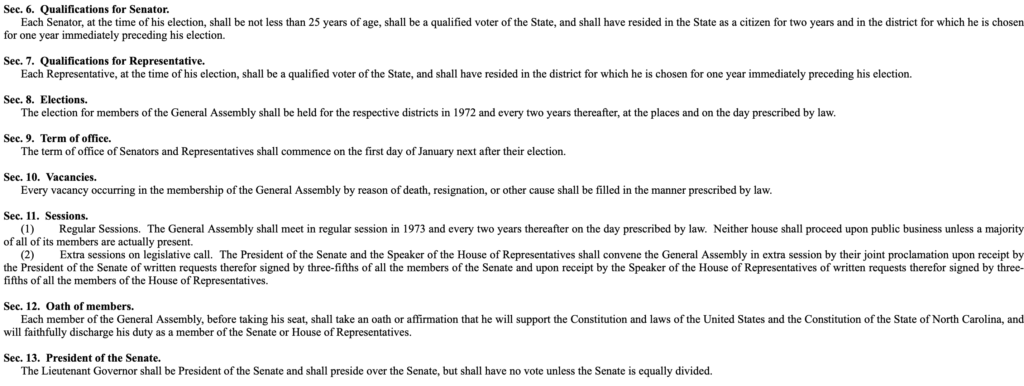
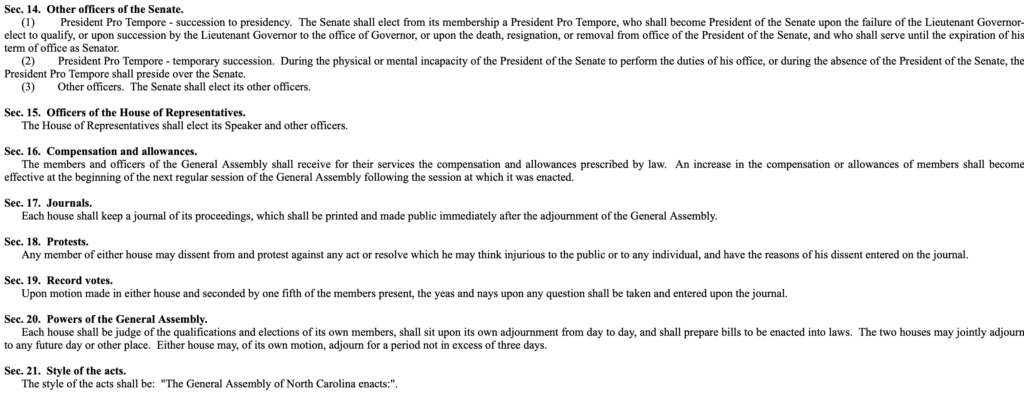
After the section about action on bills, there are two more entries that relate to the General Assembly: one on revenue bills and one on “limitations on local, private, and special legislation.” See those below.

State Board of Education
Other than the members of the Board who are elected officials, the rest of the members are appointed by the governor, as mentioned previously. That is laid out in Article XI Section 4 of the constitution.
The State Board of Education’s power is laid out in Article 9, Section 5 of the constitution, which states:
“The State Board of Education shall supervise and administer the free public school system and the educational funds provided for its support, except the funds mentioned in Section 7 of this Article, and shall make all needed rules and regulations in relation thereto, subject to laws enacted by the General Assembly.”
Here is the text in the state constitution related to the State Board of Education.

The state statute, created by acts of the General Assembly, gives more information on the roles and powers of the State Board of Education, state superintendent, and state Department of Public Instruction.
Chapter 115c-12 of the state statute lays out further the “Powers and duties of the Board generally,” including apportionment of state school funds, “power to make provisions for sick leave and for substitute teachers,” power to “adopt and supply textbooks,” “power to develop content standards,” and more. You can find it here.
Chapter 115C-11 lays out the organization and internal procedures of the Board. This includes how the Board picks its chair and vice-chair, who the advisors are, and what personnel the Board can appoint.
Additionally, after the Board adopts policies, some of those policies go to the state’s rules review commission, which “is charged with reviewing and approving rules adopted by state agencies,” according to the commission’s website.
The Commission’s authority is in General Statute 143B-30.1. And the actual rule making procedures are laid out in Chapter 150b of the Administrative Procedure Act.
The State Board actually sued to get out from under the thumb of the commission back in 2014. But the State Supreme Court said in 2018 that the State Board was not exempt.
Superintendent of Public Instruction
The state Superintendent of Public Instruction is directly elected by voters to a four-year term. Article XI Section 4 of the state constitution explains the role of the state Superintendent of Public Instruction.
“The Superintendent of Public Instruction shall be the secretary and chief administrative officer of the State Board of Education.”
Chapter 115C-18 of the general statutes contains information on the state Department of Public Instruction (DPI) and more information about the role of the state superintendent, including powers and duties. The powers and duties of the state superintendent are in chapter 115c-21.
The superintendent’s powers are divided into two core responsibility in state statute: administrative duties and duties as the secretary of the State Board.
The administrative duties include organizing and establishing the Department of Public Instruction and keeping the public informed about the “problems and needs of the public schools.”
The duties as State Board secretary include administering “funds appropriated for the operations of the State Board of Education and for aid to local school administrative units,” keeping the Board appraised of developments in public education, and making “recommendations to the Board with regard to the problems and needs of education in North Carolina.”
Legislation in 2016 transferred some of the powers previously held by the State Board of Education to the state superintendent. Among other things, the legislation and resulting court case clarified that the superintendent is the head of DPI, rather than the State Board. The state superintendent was also given direct control “over all matters relating to the direct supervision and administration of the public school system.”
Prior to lawmakers’ action, many of the superintendent’s powers were delegated by the State Board. The State Board sued over the changes, but the state Supreme Court ultimately found in favor of the General Assembly.
Local Boards of Education
Starting with 115C-35 is a section in the state statute about local boards of education.
The section begins by talking about how a local board of education is constituted and then goes into the powers that such boards have.
“All powers and duties conferred and imposed by law respecting public schools, which are not expressly conferred and imposed upon some other official, are conferred and imposed upon local boards of education. Said boards of education shall have general control and supervision of all matters pertaining to the public schools in their respective administrative units and they shall enforce the school law in their respective units.”
Later sections lay out how elections should occur, compensation for board members, and the organization of boards, before a longer section (115C-47) that lays out duties of the board in addition to the ones granted in the quote above.
Those duties include “to provide students with the opportunity to receive a sound basic education,” to establish and maintain kindergartens, to administer federal and private funds, to assure attendance records and “appropriate class size,” to provide for teacher training and food services, and much more.
Perhaps one of the most significant duties granted local boards of education by the state statute is that of electing a superintendent. In addition, local boards have the power to “prescribe” the duties of the superintendent and to “remove a superintendent, when necessary.”
There are a lot of moving parts that go into the makeup of the state’s public education system. It takes a deep dive into the state constitution and state statute to get a full picture, but we hope you now have a better idea of who is involved and how they get their powers.



